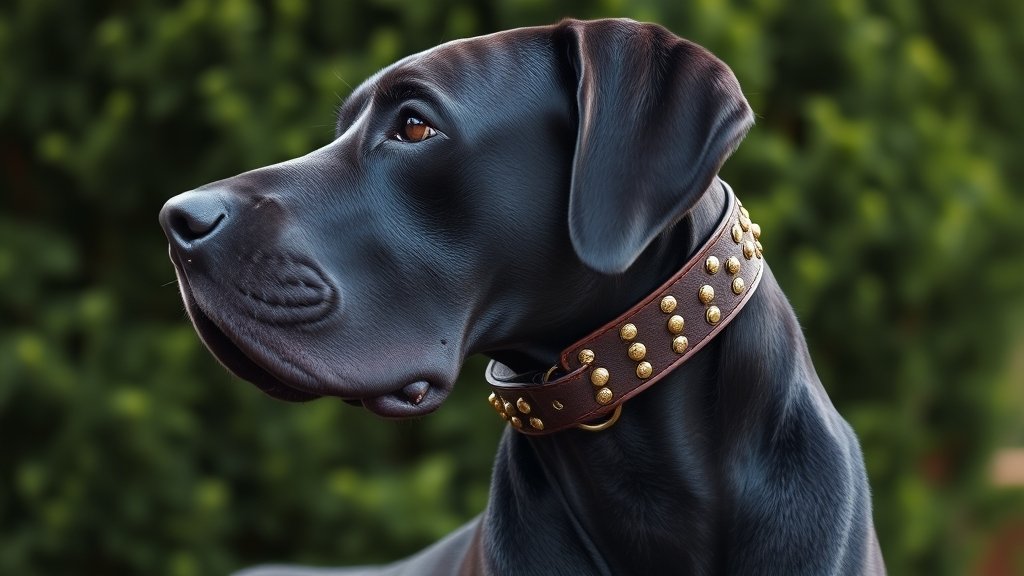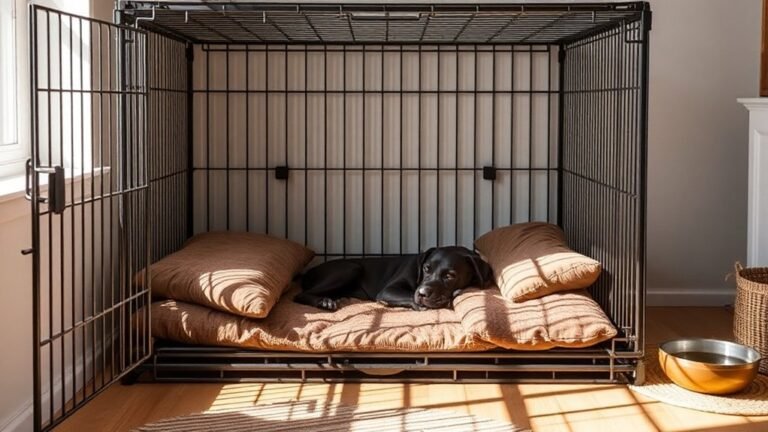Best Great Dane Collar
Best Collar for Great Danes
Woof! Let me tell you about finding the perfect collar for us, Great Danes. Trust me, I know what I’m talking about – I’ve been wearing collars my whole life!
First things first, we’re big dogs with prominent personalities, so we need collars that won’t snap when we get excited about squirrels. My humans learned this the hard way when I broke three flimsy collars in one week. Oops! Look for tough stuff like thick nylon or leather that can handle our enthusiasm.
Size matters too, and boy, do we grow fast! One day I’m a cute puppy, and the next day my collar looks like a bracelet. Get something adjustable so you don’t have to buy a new one every month. Your wallet will thank you, and so will we!
Martingale collars are pretty neat because they tighten just enough to keep us from slipping out, but they won’t choke us. Breakaway collars are cool too – they pop open if we get stuck on something. Smart thinking, humans!
Padding is our best friend. Without it, collars can rub our necks raw, and nobody wants a grumpy Great Dane. Reflective strips are awesome for evening walks because they’re hard to miss, but it’s better to be safe than sorry.
PetSafe and Blueberry Pet make some perfect collars for giants like us. They’re strong, comfy, and some even come in fun colors. Because looking good is almost as important as being comfortable!
Understanding Great Dane Collar Needs
Let me tell you, finding the right collar when you’re as big and strong as me isn’t easy. Trust me, I’ve snapped a few cheap ones during my enthusiastic squirrel-chasing adventures!
First things first – material matters! My humans learned this the hard way after I destroyed three flimsy collars in one week.
Now they stick to the tough stuff like nylon or leather. These materials can handle my powerful neck when I suddenly spot a cat across the street. Plus, leather makes me feel super fancy, like I’m wearing a designer accessory!
Training collars can be pretty helpful, too, especially when I’m learning not to drag my humans down the sidewalk like a sled dog. But here’s the thing – they need to be comfortable!
Nobody wants a collar that pinches or hurts. We Great Danes might be giants, but we’re gentle giants with feelings. A good training collar helps me learn manners without making me miserable.
The best collars are the ones that fit just right and can keep up with all my daily adventures, from morning walks to backyard zoomies. Proper collar selection is crucial for ensuring my comfort and safety during our outdoor escapades!
Because let’s be honest, life’s too short for uncomfortable accessories!
Top Collar Types for Great Danes
First up are flat collars. These are like the jeans of the collar world – classic and they go with everything! Mom loves picking out colorful designs for me, though I secretly wish she’d choose the one with bacon prints more often.
These work great for us, gentle giants who don’t pull too much on walks.
Then there are martingale collars, which sound fancy but are actually pretty smart. They tighten a little when we pull but won’t choke us like those scary choke chains. Perfect for when I spot a squirrel and forget my manners!
They give our humans more control without making us uncomfortable.
Harnesses are fantastic if you’re like my buddy Rex, who has a sensitive neck. They spread the pressure across our chest instead of our throat. Plus, they make us look like we’re ready for adventure – or maybe like we’re working dogs with important jobs!
Breakaway collars are the safety heroes. If we get our collar caught on something during playtime (which never happens to careful dogs like me… okay, maybe once or twice), these collars will snap open to keep us safe.
The material matters too! Nylon is tough and comes in fun colors, while leather gets better with age – kind of like us dogs! Choosing the right collar type is essential for our comfort and safety. Whatever you pick, make sure it’s comfortable because we wear these things all day long.
With all these choices, every Great Dane can find their perfect match!
Key Features to Look for in a Collar
What I Want in My Collar (From Your Favorite Great Dane)
First up, you’d better make sure that collar is tough as nails. I’m a big dog with a big personality, and I like to explore everything. My collar needs to handle my enthusiasm when I see a squirrel or when I get the zoomies in the backyard. Get me something made of strong materials that won’t fall apart when it gets wet from my slobber or that time I decided to take a dip in the pond.
Now, let’s talk style! I want to look good when we’re out on our walks. Pick a color that shows off my amazing personality. Maybe something bold that matches my confident attitude, or perhaps something classic that makes me look distinguished. After all, I am basically a horse-sized dog, so I need to look the part!
Here’s something super important – make sure my collar has padding. My neck is precious, and a soft, cushioned collar makes all the difference during our daily adventures. Nobody wants a sore neck after chasing tennis balls all afternoon.
And please, please get one with those shiny reflective strips! When we go out for late-night potty breaks, I want cars to see me coming from a mile away. Safety first, humans! Also, considering my size and strength, it’s crucial to choose a collar that is designed specifically for large breeds to ensure both comfort and safety.
| What I Need | Why It Matters to Me |
|---|---|
| Tough Materials | Handles my Great Dane strength |
| Cool Colors | Makes me look awesome |
| Soft Padding | Keeps my neck comfy |
Sizing and Fit Considerations
Getting Me the Perfect Collar – A Great Dane’s Guide
First up, you need to measure my neck properly. Wrap that measuring tape around the thickest part of my neck – yeah, that chunky part where all my muscles are! Don’t make it too tight, though. I still need to breathe and bark at the mailman, you know. A good rule is fitting two fingers under the collar. Any tighter and I’ll give you my sad puppy eyes.
Next, let’s talk width. I’m not a tiny Chihuahua, people! My collar needs to be wide enough to handle my enthusiastic pulling when I spot a squirrel. A wider collar spreads out the pressure so I don’t feel like I’m being choked when I get excited. Think of it like wearing a belt versus a rope around your waist.
Don’t forget about adjustability! I’m still growing (believe it or not, I can get even bigger), and sometimes I put on a few pounds during the holidays when everyone feeds me turkey scraps. An adjustable collar means you won’t have to buy me a new one every few months. My humans’ wallets will thank you!
Also, make sure to choose a collar made from durable materials, as Great Danes are known for their strength and elegance. Get these things right, and I promise to be the happiest, most comfortable Great Dane on the block!
Recommended Brands and Products for Great Danes
Now that we’ve figured out how to get the perfect collar fit, let me tell you about some awesome brands that make collars just for us, Great Danes! Trust me, when you’re as big and strong as we are, you need the good stuff.
PetSafe makes some really cool collars that can handle all our Great Dane shenanigans. You know how we like to pull on our leashes when we see a squirrel? Yeah, these collars won’t break when we do that. They’re super tough but still look pretty stylish on our giant necks.
Then there’s Blueberry Pet – and no, they don’t taste like blueberries (I checked). These guys make collars that are both strong AND fashionable. Because let’s be honest, we Great Danes are basically supermodels of the dog world, so we need to look our best!
If your humans want to spoil you rotten, tell them to check out Pooch Outfitters. These collars are fancy enough for us royal Great Danes. They’re like the Ferrari of dog collars – beautiful, well-made, and perfect for showing off at the dog park. Additionally, it’s important to choose collars that can withstand a Great Dane’s size and strength, ensuring safety and durability during walks.
With any of these brands, you’ll look amazing AND your collar will last through all your Great Dane adventures. Because we deserve collars as awesome as we are!
Final Thoughts
Woof! So here’s the deal, fellow dog lovers – picking the right collar for us Great Danes is like choosing the perfect sneakers for running a really long race. Trust me, I know what I’m talking about here!
We Great Danes have some pretty special needs (and I’m not just talking about needing an extra-large food bowl). Our necks are big and strong, but we’re also gentle giants who just want to be comfortable while we’re out showing off our awesome size.
When my human is collar shopping for me, I really hope they think about the important stuff – like making sure it fits just right and has all the cool features that keep me safe. A collar that’s too tight makes me feel like I’m wearing a turtleneck in summer, and one that’s too loose might slip right off when I’m chasing squirrels!
The best part about getting the perfect collar? Not only does it keep me safe when we’re out on adventures, but it also makes me look even more magnificent than I already am (and trust me, that’s saying something).
So let’s make sure you pick the collar that makes both of us happy – because a comfortable Great Dane is a happy Great Dane!







2 Comments